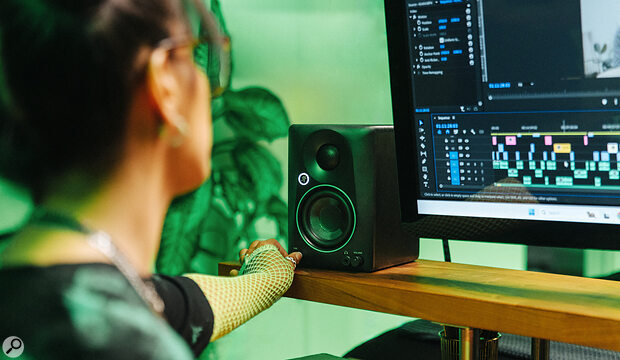Mackie’s new dinky studio speakers are designed for both work and play!
In this latest version of their compact desktop powered speakers, Mackie have tried to cover all bases from home entertainment to gaming to desktop music production and mixing. To that end, they offer the ability to adjust the voicing to suit the application, so if you want more thump for a party you can have it, but then when you want a more honest approach for music making, you can have that too. With the front‑panel Tone knob turned all the way left, you get a flat frequency response. Turn it to the right and a smile curve is applied for more low end and more high treble. This model also has a rear‑panel location switch to compensate for desktop or bookshelf placement.
As the name suggests, the CR3.5 Gen 3 has a 3.5‑inch woofer. This crosses over at 3kHz to a one‑inch silk‑domed tweeter, which is protected by a perforated grille. The amplification is Class‑A/B, and total power is quoted at 50 Watts. As with its predecessors, all the electronic circuitry is located in one speaker, with a two‑core wire feeding a passive speaker at the other side. Both speakers utilise passive crossovers. A Left/Right switch allows the powered speaker to be located at either side. All the necessary cables are included with the speakers.
The cabinets are rear‑ported and the user has a choice of quarter‑inch jacks, RCA phonos or a 3.5mm TRS mini‑jack for the input. Another version of the system, called the CR3.5BT, offers an additional Bluetooth input but is otherwise identical. The mains comes in on a two‑pin figure‑8 connector and there’s a rear‑panel master mains switch as well as an on/of switch built into the front panel volume control. There’s also the familiar light‑up Mackie ‘running man’ logo to show the speakers are powered up. Next to the volume control is a headphone jack, the use of which mutes the speakers. Size‑wise, these monitors are similar to the earlier versions and indeed to many competing mini monitors/multimedia speakers, at 206 x 140 x 180mm and with a total weight of 3.7kg, so they won’t take up too much real estate in the smaller studio.
While the speakers only need a two‑pin mains supply to operate safely, it could be argued that a mains ground might still be useful in desktop systems running on laptop computers, as the chances are that nothing else in that system will be grounded and that can lead to hum or interference making an unwelcome appearance. I had no such problem when testing with my laptop system, but having one ground connection can help avoid problems, especially when recording electric guitars.
Little Boxes
By way of performance, you can’t expect ground‑shaking bass from a such a small speaker but they still manage to sound satisfyingly punchy, with a response extending from 70Hz to 20kHz (‑3dB). Their peak SPL is 100dB at one metre, which is loud enough for safe desktop monitoring.
I tried them with a variety of musical styles and found them to be detailed without sounding aggressive; vocals are handled kindly and low‑end sounds such as kick drums retain definition.
Sonically I feel that these speakers exhibit improved clarity when compared with earlier versions, and they have excellent stereo imaging without excessive low‑frequency overhang given their size and the reflex porting. I tried them with a variety of musical styles and found them to be detailed without sounding aggressive; vocals are handled kindly and low‑end sounds such as kick drums retain definition. Of course these little speakers won’t rival esoteric monitors for accuracy, and you couldn’t expect them to, but for music production and mixing in a small room, they tick all the important boxes, especially if you are on a tight budget. I’d be very happy to use them in my Studio B (my upstairs office), and as long as you do a second opinion run‑through on your headphones (which is always advisable for checking the low end, especially when working in a small room) they are not going to stand in the way of you achieving a well‑balanced mix.
In summary then, a worthwhile upgrade that still costs less than you’d expect to pay for an overdrive pedal.
Summary
The Gen 3 CR3.5 is ultra‑portable, with a surprisingly well‑balanced sound, while the voicing control allows it to perform double duty as both a home studio and home entertainment system. While you can’t expect ‘big boy’ performance from such small speakers, I can’t find anything to complain about given their modest size and cost.
Information
CR3.5 Gen 3 £105, CR3.5BT Gen 3 (with Bluetooth) £130. Prices are per pair including VAT.
Source Distribution +44 (0)20 8962 5080.
CR3.5 Gen 3 $99, CR3.5BT Gen 3 (with Bluetooth) $129.99. Prices are per pair.
Mackie +1 800 258 6883.

